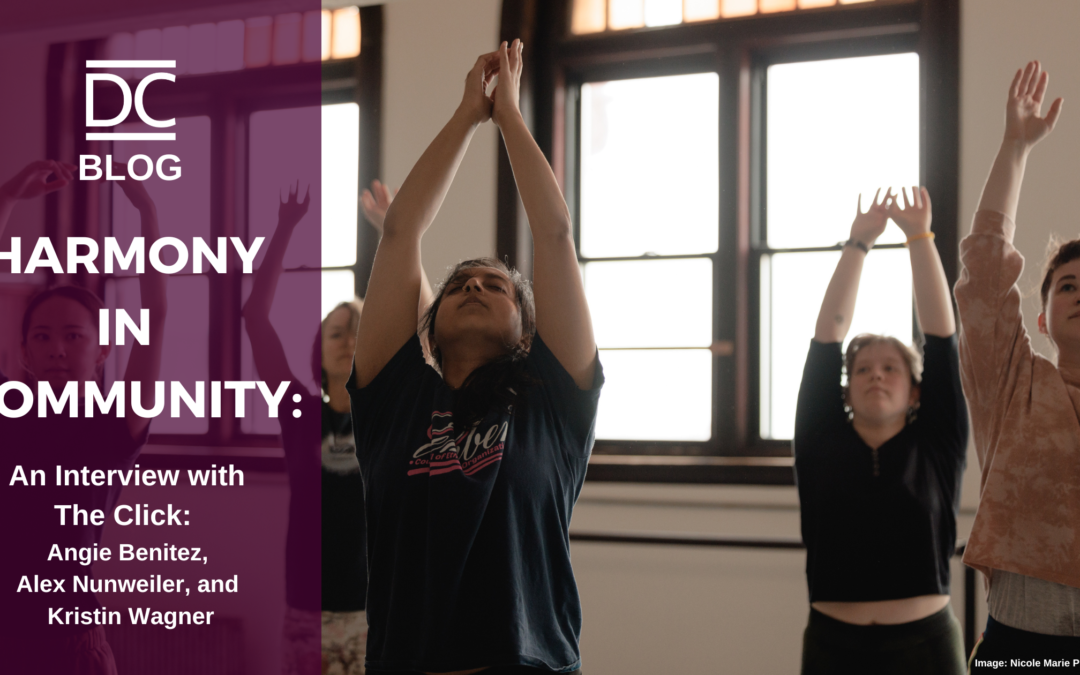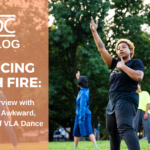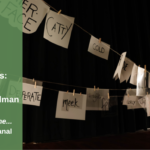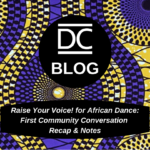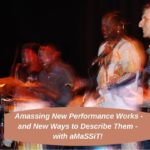When I first moved back to Boston in the Fall of 2022, I was looking for community-oriented dance classes that felt accessible and welcoming. You can imagine my thrill when I stumbled across The Click’s classes. After taking their Community Contemporary class and climbing down The Dance Complex’s stairs all the way from Studio 6, I knew I had found a dance home. Founded in 2021 during a time when the global pandemic had forced us all to reevaluate our relationship with dance, The Click’s story is one of evolution and adaptability, as they’ve cultivated a unique approach to collective leadership, emphasizing collaboration, and the shared responsibility of its members. Their classes and programs continue to evolve, responding to the needs of both the collective and the wider community, making dance a more inclusive and welcoming space for all. Read on to learn more about The Click, a young, evolving, proactive, and spunky collective, and their ventures in changing the dance landscape, one balloon and cake smash at a time.
CJ Donohoe: I am curious about the beginnings of The Click and the implications of starting a collective within a global pandemic.
Kristin Wagner: For many of us, obviously the pandemic brought about a change in our practice, how we practice, and who we practice with. Nationally and globally, it also sparked a lot of personal reflection on what we actually want to be doing with our time, and who we want to be spending our time with. For me personally, I was feeling very fearful of returning to dance, not just because of Covid, but because I hadn’t been dancing in large spaces with other people and I have class phobia to begin with. So getting back in the mix of things when I felt so removed was feeling really scary to me. I was looking for my own safe space to come back to dancing. So, I asked a funder, David Orr at Boston Moving Arts Productions, if he would fund a residency at the Complex at Canal space for me and some select friends to start taking class together again. We made this little cohort where everyone was paid to teach and take class, and we took class once a week for a few months. That was the foundation that grew and blossomed into making work together, teaching others, and opening up this safety net to include more people.
Angie Benitez: Even though The Click was Kristin’s thought baby, she was really clear from the beginning that she wanted this to be something that we all gradually took on more responsibility. It was never her company, but it was our collective. I also found that I had a shift because I mostly teach dance to youth and that’s where my comfort zone is. So having the opportunity to dance with other professionals and teach professionals that were paying to take my class and have this group of people that said, “Yes Angie you can teach class and you know what you’re talking about,” was really affirming and served as career development for me. Seeing how everyone else taught their classes and having parallel teaching served as a really good pedagogical experience.
Alex Nunweiler: I have been a part of collectives before and my experiences were varied. Some of them were really like one person in charge and the rest of us just showed up – hardly collective, where in The Click we can move in and out and be attentive to what we need to be attentive to. Yesterday, Kristin ran my rehearsal and I zoomed in because I was sick and couldn’t be there. There is this load sharing that makes sense for our group that is based on education. So if we educate one way, we treat others that way, our rehearsals are redefining rigor, our catchphrase, and that all starts with an educational founding which was really important for us and it’s the reason that we bring different types of classes to different populations. We all came in having some sort of teaching experience, even if it was only to our friends or leading a rehearsal. That’s a piece that was really important to us as we started.
CD: I’m interested in The Click operating under a lateral power structure, and if you could speak more on what that looks like.
AN: We’re figuring it out! It changes every six months based on what we need right now, who’s creating work, who’s doing social media, who’s writing grants, and then, as schedules and what we need allow, we can go in on these different roles. So, Angie is our Reel person right now, making all of our wonderful Instagram Reels. Audrey took over making Weekly Rundown posts on social media. Since it’s grant season, Kristin and I have been tag teaming that a little bit more and getting feedback from other people. I don’t feel like the biggest load is all on one person, we really spread out the responsibility.
AB: This lateral structure and the nature of our members offers flexibility where there are some members that are only teaching because that’s what they have the bandwidth for, or other members that are here to consult, support, and help spread the word.
KW: It’s definitely not to my knowledge or experience a common way to run a collective. I have spearheaded programs before where it has been all on me and though it was great to develop skills, I really didn’t want this to be that. I’m a person who needs a lot of stimulation and I can’t not do lots of creative projects at once. This means I couldn’t be the only person to spearhead this project because I wasn’t giving up my other jobs. There are other people who similarly say, “ I don’t have much to give right now but I want to be part of this and I want to give meaningfully and so this is the way I can do that”. So we look at the load, see who’s taking what, and adjust accordingly. It’s definitely hard, and it leaves gaps that we need to figure out how to fill, but I think for being in the third season of a relatively new concept, we’re doing okay.
CD: I’d say so, for sure. I have found such a home in your classes and I really look forward to them. I’m wondering if you can say more about this partnership with The Dance Complex and what drew you here, particularly as you continue to develop works as part of the Bloom residency and continue to offer a plethora of workshops.
KW: A lot of it comes from the personal relationships that I have built with The Dance Complex over the past 12 years. When I decided to do this and figured out who I wanted to do it with, I knew all these members’ personal missions aligned with The Dance Complex’s mission of opening up doors to dance. I knew I was going to need to leverage a lot of personal relationships to make this happen, and for me, those relationships exist at the Complex. I started working at The Dance Complex at 23 and I was there for a very long time – I’ve just been in and out of that building for so long and it’s also just such a home for so many different dance communities. It was the perfect place for us to put our feet.
AB: One of the appeals of The Dance Complex is there are so many different types of people and movers that come into the space, that’s a big draw for us. Our classes do tend to be pretty inclusive, for example, Yoga for People Who Move – it’s right there in the title, you don’t have to be a dancer, and you don’t have to have experience. It’s all-encompassing. Similarly, with our Community Contemporary class, the focus isn’t necessarily on looking a certain way or having a certain aesthetic. We feel like that belongs in a space that can attract lots of different people.
AN: The Dance Complex is where people go. You can get there on the T, you can drive, you can usually find a parking spot, and the building itself is accessible for a lot people.
CD: From witnessing and taking your classes, it seems like there are classes that grow with a particular collective member, how have classes shifted and evolved over the three seasons?
AB: Something that we’ve been trying to focus in on lately is allowing the evolution of our classes and what’s going to make sense number-wise, what people are actually coming to, what we can fund, and also developing consistency there.
KW: There are definitely classes that are people’s babies and the babies grow and change identities sometimes. So, Exhale was my baby and I was teaching that on my own. When the Dance Complex wanted it to continue to run it, I was like, that’s great, I just can’t be the only one doing it. That’s when I brought in Lonnie and Angie to teach it with me, just rotating weeks. Eventually, though, the numbers were dropping. I think people liked the concept, but it was hard to keep it running weekly. At the same time, I was thinking a lot about Angie’s personal practice and the way Alex was getting more interested in open-level style teaching, and they actually threw out the idea for a community-based class… and I realized that class, Community Contemporary, was filling the need that Exhale was originally intended for. A lot of evolution comes from group dialogue and talking through what we want to teach and the harmony of staying on mission, staying passionate, and staying funded. The classes that remain usually fit all three of those elements. We have programming that happens at schools and senior centers that pay nicely, so it’s a financial check, but also it’s personally fulfilling for the teachers and it’s on mission. Sometimes it’s experimental, like Yoga for People Who Move. A few people in the community had asked if we could do a yoga for dancers class and Alex and I like to teach yoga, so we’re seeing how it goes.
AN: It’s also really hard to find an hour and a half yoga class, but when we frame it as, for the right price for an hour and a half, you can breathe with us, I’ll read a little meditation card, I’ll give out some oils, here’s some experimental time. It can be so rigid in this mindset of a Westernized version of yoga, and we both strive to bring something else into that class. Yoga right now is my jam. Last year, Angie and I shared Thursday morning Community Contemporary but people shared they wish they could make a 10 am every week, but they have a nine to five job. So if you see things moving around, it’s because we’re listening to the people who come into the space. Like Kristin was saying, if it fills the need for the teacher and the community, that’s our jam.
KW: Alex and I also have business degrees. To be fully transparent, as I’m hearing this, it sounds like a very hippie crunchy way of describing a SWOT analysis, which are strengths, weaknesses, opportunities, and threats. We were teaching an intermediate-advanced technique class on Thursday mornings, and it wasn’t doing well. Then we realized that’s the same time VLA DANCE was offering their intermediate advanced contemporary class at the time, and they had more turnout. So we’re like, why are we doing this? Let’s offer something different to a different community. In that way, we try to leave space for other companies in the area to do their thing and we can do ours and we don’t have to “compete”.
CD: I really appreciate your transparency and giving us a peek behind the curtain. I’ve heard you all speak so passionately about accessibility and The Click offers a lot for community access, utilizing Card to Culture admission, having tiered access ticket prices, and free movement workshops across Greater Boston. Why is access and community central to The Click?
AB: I’ve felt that in the dance community at large, I have felt really marginalized as a dancer who is queer, biracial, and fat. The Click has been really helpful for me, finding a space where I can hold and welcome other folks like me. I’ve been finding more and more queer movers coming to my classes, it warms my heart that folks feel comfortable coming to my class and allowing me to hold space for their bodies that have been systematically marginalized. Also, me being who I am and existing in the space helps open up room for other people who may not feel comfortable because that’s the problem that I’ve had – not seeing anyone (or few people) like me. Also having options and alternatives to movements and knowing that it’s okay if you need to sit or change something completely or lay down and cry during a yoga class, instead of pushing through another sun salutation.
KW: I am probably the least educated on accessibility of the people in this particular space, but it is something that I care a lot about, and it’s something that I’ve really been enjoying learning about. It’s a really important value for Lonnie, I know it’s a really important value for Angie and Alex. Those three in particular within our collective are usually the first ones to bring up accessibility when we’re talking about a new program. I feel like I just learn so much by absorbing those ideas and it’s part of why lateral structures are so helpful: it’s not one person thinking of everything. All ideas are welcome and they’re valid and entertained. I read a book while I was hiking through Canada called Big Magic by Liz Gilbert and she writes about the paradox of art and how everything matters and also nothing matters, and what we’re doing is important and it’s also so irrelevant. Holding this paradox has been really healing for me because there’s so much pressure in dance and it has historically clammed me up a lot in terms of self-censoring and being afraid to go to class if I’m not good enough. A lot of times, you walk into a space feeling like you already need to be an expert in choreography, performance, and technique. So when I had this breakthrough with this mindset of it doesn’t really matter – it’s important but also doesn’t need to be so freaking pressure-filled – that helped me think through how we structure things so that people remember that you’re allowed to be an imperfect human, in every space, especially in a dance space.
AN: Being part of The Click has not only opened me up to other Click members but also other people who will come into a space when they’re invited. It’s one thing to say, it’s here if you want it, but it’s another thing to say, please come. We say, please come. It feels like a lot more inviting space being with The Click, starting out with those classes and meeting a lot of new people. I think I met Angie one time before taking class together and now we’re besties, we went to Denver and did a presentation together. I feel like we keep attracting the right people into our space, and changing some minds, if they come in with something different in their head, too. We’re pretty committed to changing that dance landscape in one way or another.
CD: What’s on the horizon for The Click? What’s going on? What’s in the future?
AB: I am personally getting myself hyped for a repertory experience we’re going to start providing. Details are TBD, but we’re really excited to start reaching out to community members soon and offering an option to be a part of a professional performance and do an intensive class taking and package together, and offering the space to perform. I think it’ll be especially beneficial to folks that maybe minored in dance in college or danced in high school or have never danced before but have had this dream and come together to create a piece and get that magic of performing and being seen.
KW: And even before that, Angie has her first solo show! My Guide to Feeling It All will be Saturday, November 18th at 7:30 at MAGMA in Gloucester.
AB: There’s gonna be a chocolate be in the pre-viewing experience and then there’ll be a chance to chat with the cast and collaborators on the behind-the-scenes aspect.
AN: Edge of Aquarius is the other project we’ve been working on. We have a few guest artists that have joined our cast. I’m actually talking to more people this weekend to add, so we have lots of people. Lots of cake smashing, balloon dropping, laughing, crying, the mixed emotions of birthdays. That will be in January. And then our March show will combine The Click with community movers and kids partnered with a studio in Sudbury, so it’s gonna be a varied split bill.
KW: Those performances are January 19th through the 21st at the Foundry, and March 8th through the 10th at the Foundry.
Keep up with all things The Click on their Instagram and website! Register and learn more about Monday 10-11:30 Barefoot Ballet, Tuesday 10-11:30am Intermediate/Advanced Contemporary, and Thursday 10-11:30 Yoga for People Who Move here.

